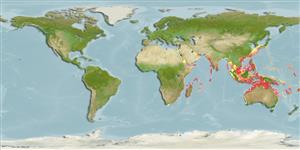Classification / Names
Common names from other countries
Main reference
Size / Weight / Age
Max length : 42.1 cm TL (female); common length : 25.0 cm TL male/unsexed; (Ref. 30573); max. published weight: 0.00 g; max. reported age: 4 years (Ref. 168)
Length at first maturity
Lm 19.9, range 20 - 24.5 cm
Environment
Marine; pelagic-neritic; oceanodromous (Ref. 51243); depth range 20 - 90 m (Ref. 12260)
Climate / Range
Tropical; 17°C - ? (Ref. 54861), preferred 27°C (Ref. 107945); 34°N - 24°S, 30°E - 180°E (Ref. 54861)
Distribution
Indo-West Pacific: Red Sea and East Africa to Indonesia, north to the Ryukyu Islands and China, south to Australia, Melanesia and Samoa. Entered the eastern Mediterranean Sea through the Suez Canal.
Countries | FAO areas | Ecosystems | Occurrences | Introductions
Short description
Dorsal
spines
(total): 8 - 11;
Dorsal
soft rays
(total): 12;
Anal
spines: 0;
Anal
soft rays: 12. Head longer than body depth. Maxilla partly concealed, covered by lachrymal bone but extending to about hind margin of eye. Bristles on longest gill raker 105 on one side in specimens of 12.7 cm, 140 in 16 cm, and 160 in 19 cm fork length specimens. A black spot on body near lower margin of pectoral fin. Interpelvic process small and single. Swim bladder present. Anal spine rudimentary.
IUCN Red List Status (Ref. 115185)
Threat to humans
Harmless
Human uses
Fisheries: highly commercial; gamefish: yes; bait: occasionally
Tools
Special reports
Download XML
Internet sources
Estimates of some properties based on models
Phylogenetic diversity index
PD50 = 0.6250 many relatives (e.g. carps) 0.5 - 2.0 few relatives (e.g. lungfishes)
Trophic Level
3.2 ±0.38 se; Based on food items.
Resilience
High, minimum population doubling time less than 15 months (K=0.2-1.9; tm=1; tmax=4; Fec = 68,500)
Vulnerability
Low vulnerability (19 of 100)
Price category
